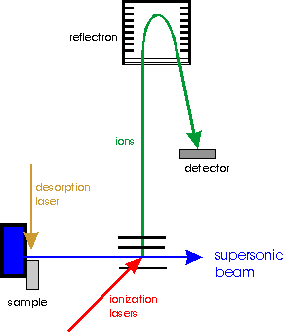Laser Desorption
We use short laser pulses to lift fragile molecules from surfaces. This offers an advantage over thermal methods since many samples when heated can decompose. However fragmentation can be minimized when the timescale for heating is shortened. The rates required to desorb molecules without fragmentation are on the order of 1011 K/sec. This corresponds to a 1000 K temperature jump in 10 ns and can be accomplished using lasers. Laser desorption also keeps the molecules as neutrals and requires a separate ionization step (for detection in the mass spectrometer). While separation of desorption and ionization steps can cause additional complications, it offers the possibilities of greater control over ionization. By employing one or two color resonant two-photon ionization [R2PI], VUVand double resonance photoionization schemes we can perform spectroscopy in the source of the mass spectromter. |
|
Jet Cooling
After laser desorption, neutral molecules are entrained in a supersonic expansion with an inert drive gas (we usually use argon) that is injected by a pulsed solenoid valve. During the expansion the sample transfers its internal energy to the carrier gas through two body collisions and relaxes its excited rotational and vibrational states. The sample's internal temperature can be several tens of degrees Kelvin or below. Most of the sample molecules end up in the ground electronic state and at the lowest vibrational level (v"=0). Jet cooling opens up the possibility for well resolved vibronic spectroscopy and also helps reduce fragmentation upon ionization in mass spectrometry. Also by controlling the source conditions, we can generate clusters of desorbed molecules with each other or with water that will be seeded in the drive gas
2 photon Ionization - TOF mass spectrometry
After neutral laser desorption and jet cooling, we employ various lasers to ionize and detect the molecule in a reflectron time of flight mass spectrometer (reTOF MS). If we use resonant two photon ionization (R2PI, sometimes referred to as resonance enhanced multi-photon ionization or REMPI), the first photon resonantly excites the molecule while a second photon ionizes the excited molecule. By varying the excitation wavelength while monitoring specific mass peaks we obtain mass selected, vibrationally resolved spectra in the excited state.






